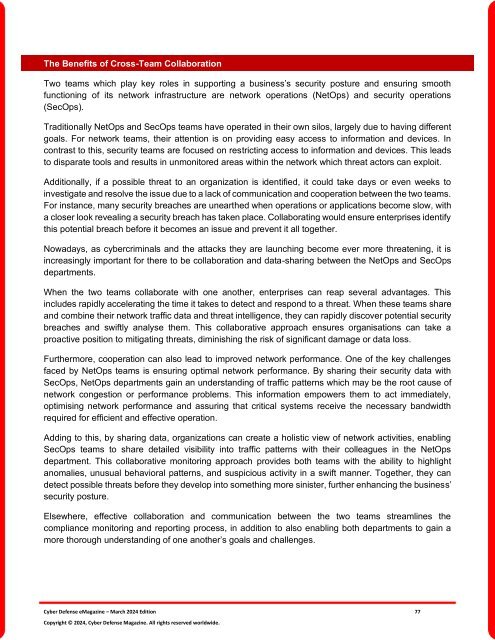The Cyber Defense eMagazine March Edition for 2024
Cyber Defense eMagazine March Edition for 2024 #CDM #CYBERDEFENSEMAG @CyberDefenseMag by @Miliefsky a world-renowned cyber security expert and the Publisher of Cyber Defense Magazine as part of the Cyber Defense Media Group as well as Yan Ross, Editor-in-Chief and many more writers, partners and supporters who make this an awesome publication! 225 page March Edition fully packed with some of our best content. Thank you all and to our readers! OSINT ROCKS! #CDM #CDMG #OSINT #CYBERSECURITY #INFOSEC #BEST #PRACTICES #TIPS #TECHNIQUES
Cyber Defense eMagazine March Edition for 2024 #CDM #CYBERDEFENSEMAG @CyberDefenseMag by @Miliefsky a world-renowned cyber security expert and the Publisher of Cyber Defense Magazine as part of the Cyber Defense Media Group as well as Yan Ross, Editor-in-Chief and many more writers, partners and supporters who make this an awesome publication! 225 page March Edition fully packed with some of our best content. Thank you all and to our readers! OSINT ROCKS! #CDM #CDMG #OSINT #CYBERSECURITY #INFOSEC #BEST #PRACTICES #TIPS #TECHNIQUES
You also want an ePaper? Increase the reach of your titles
YUMPU automatically turns print PDFs into web optimized ePapers that Google loves.
<strong>The</strong> Benefits of Cross-Team Collaboration<br />
Two teams which play key roles in supporting a business’s security posture and ensuring smooth<br />
functioning of its network infrastructure are network operations (NetOps) and security operations<br />
(SecOps).<br />
Traditionally NetOps and SecOps teams have operated in their own silos, largely due to having different<br />
goals. For network teams, their attention is on providing easy access to in<strong>for</strong>mation and devices. In<br />
contrast to this, security teams are focused on restricting access to in<strong>for</strong>mation and devices. This leads<br />
to disparate tools and results in unmonitored areas within the network which threat actors can exploit.<br />
Additionally, if a possible threat to an organization is identified, it could take days or even weeks to<br />
investigate and resolve the issue due to a lack of communication and cooperation between the two teams.<br />
For instance, many security breaches are unearthed when operations or applications become slow, with<br />
a closer look revealing a security breach has taken place. Collaborating would ensure enterprises identify<br />
this potential breach be<strong>for</strong>e it becomes an issue and prevent it all together.<br />
Nowadays, as cybercriminals and the attacks they are launching become ever more threatening, it is<br />
increasingly important <strong>for</strong> there to be collaboration and data-sharing between the NetOps and SecOps<br />
departments.<br />
When the two teams collaborate with one another, enterprises can reap several advantages. This<br />
includes rapidly accelerating the time it takes to detect and respond to a threat. When these teams share<br />
and combine their network traffic data and threat intelligence, they can rapidly discover potential security<br />
breaches and swiftly analyse them. This collaborative approach ensures organisations can take a<br />
proactive position to mitigating threats, diminishing the risk of significant damage or data loss.<br />
Furthermore, cooperation can also lead to improved network per<strong>for</strong>mance. One of the key challenges<br />
faced by NetOps teams is ensuring optimal network per<strong>for</strong>mance. By sharing their security data with<br />
SecOps, NetOps departments gain an understanding of traffic patterns which may be the root cause of<br />
network congestion or per<strong>for</strong>mance problems. This in<strong>for</strong>mation empowers them to act immediately,<br />
optimising network per<strong>for</strong>mance and assuring that critical systems receive the necessary bandwidth<br />
required <strong>for</strong> efficient and effective operation.<br />
Adding to this, by sharing data, organizations can create a holistic view of network activities, enabling<br />
SecOps teams to share detailed visibility into traffic patterns with their colleagues in the NetOps<br />
department. This collaborative monitoring approach provides both teams with the ability to highlight<br />
anomalies, unusual behavioral patterns, and suspicious activity in a swift manner. Together, they can<br />
detect possible threats be<strong>for</strong>e they develop into something more sinister, further enhancing the business’<br />
security posture.<br />
Elsewhere, effective collaboration and communication between the two teams streamlines the<br />
compliance monitoring and reporting process, in addition to also enabling both departments to gain a<br />
more thorough understanding of one another’s goals and challenges.<br />
<strong>Cyber</strong> <strong>Defense</strong> <strong>eMagazine</strong> – <strong>March</strong> <strong>2024</strong> <strong>Edition</strong> 77<br />
Copyright © <strong>2024</strong>, <strong>Cyber</strong> <strong>Defense</strong> Magazine. All rights reserved worldwide.

















